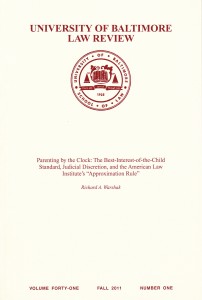At the end of a child custody trial, courts base decisions on the best interest of the child. Critics of this standard regard it as too subjective and have proposed various alternatives such as the primary parent presumption and a shared custody presumption. One proposal that may exert enormous influence is known as the “approximation rule.” The rule divides the child’s time with each parent according to the proportion of time that each parent participated in caretaking prior to the separation.
To understand why this proposal is poised to replace the best-interest-of-the-child standard, we need to know something about the sponsor of the approximation rule: the prestigious American Law Institute [ALI]. The ALI is an elite organization that promotes reform in all areas of the law. Famous jurists such as William Howard Taft, Charles Evans Hughes, and Elihu Root established the ALI in 1923. Currently, it comprises an elected membership of eminent law professors, judges, and lawyers, and ex officio membership of the Chief Justice of the United States, the Associate Justices of the Supreme Court, the Chief Judges of the United States Courts of Appeals, the Attorney General and Solicitor General of the United States, the chief justices of the state supreme courts, law school deans, and the presidents of various legal organizations, including the national and state bar associations.
Through its publications and Restatements of Law, the ALI exercises great influence on the landscape of law in the United States. The impact of its family law reform proposals, Principles of the Law of Family Dissolution [the Principles] published in 2002 after four preliminary drafts, is being felt in legislatures, courts, and law school curriculums. Professor Robin Wilson opines, “It is difficult to overstate the degree of the ALI’s influence. As of March 1, 2004, state and federal courts have cited the Restatements 161,486 times.” Professor Wilson continues, “Because of the prestige of the ALI, judges will undoubtedly rely on the Principles as they have relied on the ALI’s Restatements. Legislators are also likely to turn, rightly or wrongly, to the Principles for guidance. . . .” In debates over child custody reform, the approximation rule has become the pivotal issue. Groups that advocate for mothers and those that advocate for fathers take opposite views of the proposal.
After studying the approximation rule in great detail I concluded that it is unlikely to accomplish its goals and unlikely to represent an improvement over the status quo. In a series of three articles I described my analysis and advanced several hypotheses. Then I conducted the first empirical study of the approximation rule by surveying attorneys and child custody evaluators about the last custody trial in which they were involved. The results supported my hypotheses.

An article just published by the University of Baltimore Law Review details my most comprehensive analysis of the best-interest-of-the-child standard and the approximation rule. It reflects what I learned from responses to my earlier articles, from the approximation rule survey, and from my research on the benefits and drawbacks of judicial discretion in custody cases. The article, titled Parenting by the Clock: The Best-Interest-of-the-Child Standard, Judicial Discretion, and the American Law Institute’s “Approximation Rule” answers questions such as:
- Should the best-interest-of-the-child standard be replaced by a presumption that divides a child’s time between homes equally or according to the proportion of care provided by each parent in the past?
- What do scientific studies report about the relationship between children’s welfare and the amount of involvement of both parents?
- Does more time with Dad take away from the quality of the mother-child relationship?
- Are the benefits of greater father involvement found in families with high inter-parental conflict?
- Are courts biased in favor of mothers or in favor of fathers?
- Should custody decisions favor the parent who supports the child’s relationship with the other parent, or do “friendly parent” provisions discourage parents from protecting children?
- Is there an epidemic of judges who award custody of children to violent fathers?
- Do judges rely too heavily on the recommendations of child custody evaluators?
The article concludes that 1) public policies that encourage children’s involvement with both parents after divorce are consistent with the scientific literature and with prevailing public sentiment; 2) legislation should define the best interests of children to include parenting plans that maximize parenting time, when feasible and when no circumstances exist that endanger the health, safety, or well-being of the children or a parent, such as violence, abuse, gross neglect, severely compromised parenting due to severe mental illness or severe substance abuse, or extremely poor and harmful behavior toward the children; 3) evidence is accumulating that closer to equal distributions of time are linked to better outcomes for most children and parents; 4) an exact equal-time presumption, though, may bring similar liabilities as presumptions that elevate a single factor (e.g., gender, past caretaking, or children’s preferences) above all others. For instance, if a parent uses additional time with the children to undermine their love and respect for the other parent, this behavior may offset the benefits of more time with the parent who manipulates the children in this manner. But, more time with the parent who is the target of bad-mouthing may help children resist efforts to turn them against that parent.
As one of approximately seven articles published annually by this law review, heavily documented (414 footnotes) with citations to numerous and recent social science studies, I expect this article to influence legislation and case law regarding child custody.

4 Responses to Parenting by the Clock: Is It Time to Replace the Best-Interest-of-the-Child Standard? With What?